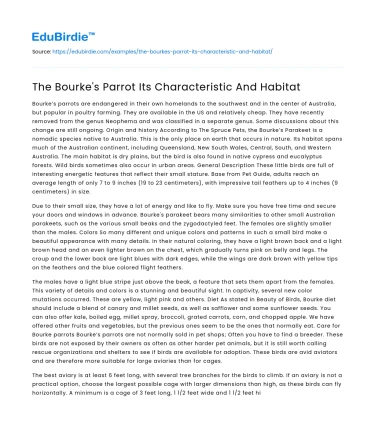Bourke’s parrots are endangered in their own homelands to the southwest and in the center of Australia, but popular in poultry farming. They are available in the US and relatively cheap. They have recently removed from the genus Neophema and was classified in a separate genus. Some discussions about this change are still ongoing. Origin and history According to The Spruce Pets, the Bourke’s Parakeet is a nomadic species native to Australia. This is the only place on earth that occurs in nature. Its habitat spans much of the Australian continent, including Queensland, New South Wales, Central, South, and Western Australia. The main habitat is dry plains, but the bird is also found in native cypress and eucalyptus forests. Wild birds sometimes also occur in urban areas. General Description These little birds are full of interesting energetic features that reflect their small stature. Base from Pet Guide, adults reach an average length of only 7 to 9 inches (19 to 23 centimeters), with impressive tail feathers up to 4 inches (9 centimeters) in size.
Due to their small size, they have a lot of energy and like to fly. Make sure you have free time and secure your doors and windows in advance. Bourke's parakeet bears many similarities to other small Australian parakeets, such as the various small beaks and the zygodactyled feet. The females are slightly smaller than the males. Colors So many different and unique colors and patterns in such a small bird make a beautiful appearance with many details. In their natural coloring, they have a light brown back and a light brown head and an even lighter brown on the chest, which gradually turns pink on belly and legs. The croup and the lower back are light blues with dark edges, while the wings are dark brown with yellow tips on the feathers and the blue colored flight feathers.
Save your time!
We can take care of your essay
- Proper editing and formatting
- Free revision, title page, and bibliography
- Flexible prices and money-back guarantee
The males have a light blue stripe just above the beak, a feature that sets them apart from the females. This variety of details and colors is a stunning and beautiful sight. In captivity, several new color mutations occurred. These are yellow, light pink and others. Diet As stated in Beauty of Birds, Bourke diet should include a blend of canary and millet seeds, as well as safflower and some sunflower seeds. You can also offer kale, boiled egg, millet spray, broccoli, grated carrots, corn, and chopped apple. We have offered other fruits and vegetables, but the previous ones seem to be the ones that normally eat. Care for Bourke parrots Bourke’s parrots are not normally sold in pet shops; Often you have to find a breeder. These birds are not exposed by their owners as often as other harder pet animals, but it is still worth calling rescue organizations and shelters to see if birds are available for adoption. These birds are avid aviators and are therefore more suitable for large aviaries than for cages.
The best aviary is at least 6 feet long, with several tree branches for the birds to climb. If an aviary is not a practical option, choose the largest possible cage with larger dimensions than high, as these birds can fly horizontally. A minimum is a cage of 3 feet long, 1 1/2 feet wide and 1 1/2 feet high. These birds are better suited to be paired with another Bourke Parakeet, although they can do it on their own provided you have enough time to interact with them. Swings are a good complement to an aviary or a cage Bourke parakeets are enthusiastic bathers. So store the pools in the cage or in the aviary. Make sure the bathwater is clean and cold. Another weekly shower with a spray bottle of warm water will give your pet bird a pleasant experience. Budgerigars are extremely social birds, and Bourke's parakeet is no exception.
Although less strenuous than other species, your bird needs at least one to two hours of interaction and exercise per day. Language and sounds Bourke, as they are called, are not really that loud. This is appreciated by the owners who live in apartments or those who prefer quieter parrots, more than the communicative races. They have their unique natural calls, which are very similar to budgerigars. These are squeaks and soft tweets that have a nice sound and will not bother you at all. They are often heard when they fly, the favorite pastime of the Bourke.
Common health problems Like other parrot species, the Bourke parakeet may be susceptible to psitacidisease, which can spread between birds and even humans. The disease causes obvious respiratory problems and is treated with antibiotics. Several viruses can also infest parakeets and cause problems such as abnormal feathers, diarrhea, and pneumonia. Budgerigars also tend to have paranasal sinus obstruction caused by Aspergillus fungus; Good nutrition and hygiene avoid this problem. Several parasites can affect the parakeets. Intestinal parasites can cause a bird to lose weight and become depressed, while mites and external lice scrape the bird and lose feathers.






 Stuck on your essay?
Stuck on your essay?

